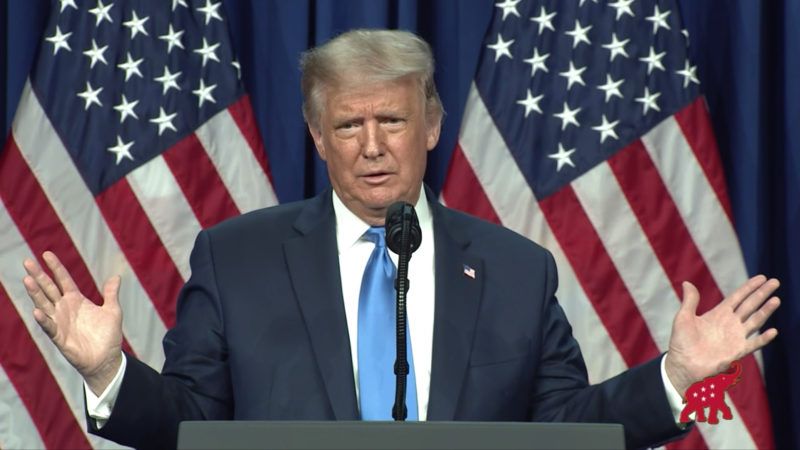Following a rather mixed record on terrestrial policy accomplishments during his first term, President Donald Trump is making his off-planet plans a part of his reelection pitch.
On Sunday, the Trump campaign released a 49-point “Fighting for You!” second-term agenda. Under the document’s Innovating for the Future section, Trump is promising to “Launch Space Force, Establish Permanent Manned Presence on The Moon and Send the First Manned Mission to Mars.”There are no further details contained in the document released Sunday.
The president will reportedly elaborate Thursday in his Republican National Convention acceptance speech and in “policy-focused speeches on the campaign trail.” Under the Trump administration, NASA has continued and expanded past administrations’ partnerships with commercial space companies to carry cargo and crew into orbit and beyond.
The most recent example of this is NASA’s successful Crew Dragon mission, in which the agency contracted with SpaceX, founded by billionaire Elon Musk, to carry two American astronauts to the International Space Station (ISS). That mission launched in late May and the astronauts returned safely earlier this month. The Crew Dragon mission was the first time American astronauts were launched into space from American soil since 2011, when the Space Shuttle program was mothballed.
The mission was also noteworthy because NASA used a “firm-fixed-price” contract with SpaceX to get the job done. Under this model, the government pays private contractors a fixed price for a particular service; in the Crew Dragon case, NASA paid SpaceX $2.6 billion to design and then launch a crew transportation system. That’s at odds with the old “cost-plus” model NASA long relied on.
This involved the agency telling contractors exactly what they wanted, then paying them for the costs of development, plus a fee. Ars Technica‘s Eric Berger explained in a May 2020 article how this was a recipe for cost overruns. “If a vehicle ran five years late and doubled its original budget, NASA was on the hook for cost overruns. This tended to not encourage on-time delivery, but eventually the government got what it wanted,” Berger wrote.
The firm-fixed-price model shifts the risk of cost overruns from taxpayers to private companies. Companies like SpaceX have to complete projects with less money and in less time than other NASA projects that still rely on the “cost-plus” model.
NASA’s shift toward using firm-fixed contracts with commercial operators began under the George W. Bush administration and was later expanded by President Barack Obama. The initial idea was to farm out less complicated ISS resupply missions to private contractors so that NASA could focus on returning to the Moon, and later, make the trip to Mars. The Trump administration is taking this idea even further.
In March, NASA announced it had signed a firm-fixed-price contract with SpaceX to deliver supplies to its planned Lunar Gateway space station, which will orbit the Moon. In April 2020, NASA announced that it had signed $967 million worth of firm-fixed-price contracts with three commercial space operators—SpaceX, Jeff Bezos’s Blue Origin, and Dynetics—to develop human landing systems for the Artemis project, which aims to return humans to the moon by 2024.
“With these contract awards, America is moving forward with the final step needed to land astronauts on the Moon by 2024, including the incredible moment when we will see the first woman set foot on the lunar surface,” said NASA Administrator Jim Bridenstine in a press release. Bridenstine, in a June tweet, suggested that commercial contractors could be used even for deep space missions.
To be clear, the turn to commercial space is hardly the stuff of libertarian futurist fantasies; it still involves government money paying private contractors to fulfill the needs of the government’s space agency. But the success of NASA’s commercial approach demonstrates what’s possible when the government reduces, however marginally, its control of space flight.
It’s possible we’ll see even more of that in a second Trump term. Given the bipartisan history of NASA’s turn to commercial spaceflight, it’s also possible we’ll get more of it under President Joe Biden as well.




